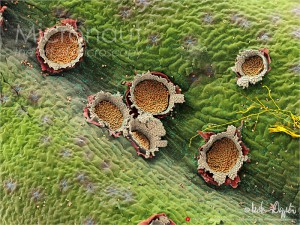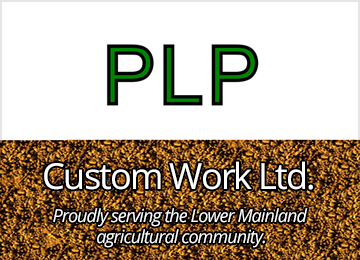Lana Harach
Herbicides. Pesticides. These words have negative connotations, and often when the general public hears them, the first, if not only thought that comes to mind is chemicals—man-made and terrible for the environment. We hear of stories where the chemicals that manage farm crops end up in streams and affect the natural habitat.
However, an extensive amount of research and testing has been put into each herbicide and pesticide so that the impact is as minimal as possible. Canada, compared to other countries, has a shorter list of chemical herbicides that are legal for producers to use. Even so, we as a society have begun to hold a new and greater respect for our earth and are eager to find sustainable ways to go about our lives and farming practices.
In addition to the effects of the chemical herbicides, weeds and pests are continually evolving, and adapting—like any other organism—to the environment. Chemical herbicides act as a section agent against weeds, and because only the individuals that survive reproduce, the weed species become resistant to the specific chemical formula. For these reasons, other weed control methods and resources are being explored. With this proactive way of thinking, biocontrol agents such as micro-organisms, macro-organisms, and natural substances are being investigated.
Fungal diseases are typically seen as disastrous and dangerous, something that could very easily destroy important crops and something to be avoided at all costs. However, in the early 1970s active research began on the development and use of a new branch of herbicide, namely mycoherbicides, developed from plant pathogenic fungi. They could benefit agriculture by “[demonstrating] that an endemic pathogen might be rendered completely destructive to its weed host by applying a massive dose of inoculum at a particularly susceptible stage of weed growth” (Patel R. and Patel D.R., 2015 pg 4532) yet at the same time leaving the wanted plants untouched.

Earlier experimentation of fungi being used as a mycoherbicide consisted of finding specific varieties of fungi that targeted the weed crop family and, preferably, a limited number of varieties within the family. As studies progressed, new varieties were bred to make the targeted section of plants more specific. Science has advanced from here; now a mycoherbicide is created by extracting only the unique section of DNA that contains the trait that targets and weakens the weed.
Mycoherbicides can infect the target plant in direct and indirect manners. Directly, the enzymes selected specifically from the fungi can degrade plant cell walls, proteins and lipid membranes—all of which weakens the plant. Indirectly, there “could be phytotoxic secondary metabolites and peptides that act as toxins that interfere with plant metabolism” (Cordeau et al., 2016 pg 45).
The application of mycoherbicides has changed with time and research. In a method known as the ‘classical strategy’ the application is simply releasing the fungi into the weed population and allowing it to populate and establish itself, continuously regulating the weeds. In this type of application the fungi persists in the environment.
Due to the concerns of the possibility of fungus evolving, another application known as the inundative strategy was developed. This is where the mycoherbicide created from the specific portion of the fungi DNA is used. It is spread much like a chemical herbicide, applying when the weed is at its weakest to avoid further development. These applications can be made as often as necessary, especially if the initial application was not as rapid as hoped. In this strategy the fungi does not persist in the environment (Boyetchko, S., 2017).
There are reasons to why mycoherbicides are gaining popularity. Some species of plants are extremely resistant to chemical herbicides and reproduce effectively. An example of these plants is the species in the Amaranthus genus; they are “listed among the most herbicide resistance-prone annual broadleaf weeds because of their high genetic variability, high production of rapidly germinating seeds, and efficient pollen and seed distribution” (Adetunji et al., 2017 pg 132). Plants from the Amaranthus genus are able to evolve to become quickly resistant to conventional herbicides due to these traits. However, there have been successful studies using a mycoherbicide developed from a species in the Lasiodiplodia genus to control Amaranthus.
There are many reasons why mycoherbicides are being reconsidered as an herbicide; however, there are also difficulties when it comes to creating the mycoherbicides. Strains are designed to target a specific plant or variety of plant through a pathogenic technique. To be successful in creating a mycoherbicide it has to be successful in a multitude of factors, such as ease of production.
How hardy the fungi will be is important for determining the ease of usage. If the fungus is extremely sensitive to UV light and dehydration, more time, effort and money will have to be invested to create a bioherbicide that is ready for the commercial market.
If the mycoherbicide requires a high level of humidity to infect the weed or has a low performance when tested over a wide range of environmental conditions, the reliability of the mycoherbicide has to be improved upon. If the mycoherbicide is not reliable the producer would have to resort to using the chemical herbicides. Not only is this costly for the producer who would have to pay for two types of herbicides, but they may miss the application period for the chemical herbicide and would likely suffer yield losses, which in turn would lead to additional monetary losses.

Mycoherbicides are seen as an organic herbicide. They are natural, made from a plant, and do not harm the environment except for the targeted weed if developed and used correctly. Be that as it may, a producer cannot use a mycoherbicide and expect it to completely eradicate the targeted weed. Rather it should be thought of as a way to control the balance of the pest population and work in cooperation with other methods of pest control and management.
Consumers want sustainability but the producers have to look at physical capability and cost efficiency in addition to the effect on the environment. So we must be careful to make certain a targeted release of mycoherbicides does not “contaminate” the environment and eradicate species diversity and that we do not create super plant diseases.
We now have a greater understanding of what affects the environment in a detrimental way, and why that is important. We need to continue to question how we can improve our practices and keep our world healthy. Research is only the beginning to discovering new ideas and options. Using fungi as a mycoherbicide to kill weeds, as an alternative with other bioherbicides or natural techniques—instead of chemical herbicides—could be one possible step in a more sustainable direction.
References
Adetunji, C., Oloke, J., Prasad, G. and Adejumo, I. (2017). Effect of Lasiodiplodia pseudotheobromae Isolates, a Potential Bioherbicide for Amaranthus hybridus L. in Maize Culture. Notulae Scientia Biologicae
Boyetchko, S.( 2017, Sept. 28). In person Interview with a research scientist who has expertise in weed biological control and applied microbiology.
Cordeau, S., Triolet, M., Wayman, S., Steinberg, C. and Guillemin, J. (2016). Bioherbicides: Dead in the water? A review of the existing products for integrated weed management. Crop Protection, (87), pp.44-49.
Patel R. and Patel D.R. (2015). Biological Control of Weeds with Pathogens: Current status and Future trends. Int. J. Pharm. Life Sci., 6(6):4531-4550.
[infobox title=’Lana Harach’] Lana Harach is in her first year at the University of the Fraser Valley working towards receiving her Bachelor of Agricultural Science. Lana’s passion for agriculture has flourished from her 10 years in BC 4H, a term as youth representative on the Qualicum Beach Sustainability Council and Director for the Arrowsmith Agricultural Association.[/infobox]
Lana Harach is in her first year at the University of the Fraser Valley working towards receiving her Bachelor of Agricultural Science. Lana’s passion for agriculture has flourished from her 10 years in BC 4H, a term as youth representative on the Qualicum Beach Sustainability Council and Director for the Arrowsmith Agricultural Association.[/infobox]












